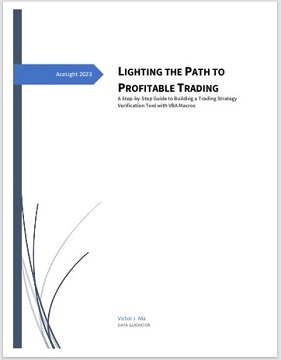Crafting an Effective Stock Market Entry Strategy: Achieving Success in Trading
|
|
A well-defined entry strategy helps maximize profit potential by allowing
traders to enter positions at optimal price levels. It aims to identify
favorable opportunities, whether it's capitalizing on a breakout, taking
advantage of a pullback, or riding the momentum of a trending stock. By
entering trades strategically, investors increase their chances of capturing
significant price movements and generating profits.
Picture this:
You're standing at the entrance of a gigantic amusement park called the
stock market. The exhilarating rides of profits and the heart-stopping drops
of losses await you. But before you plunge headfirst into the wild world of
stocks, wouldn't it be wise to have a strategy, a roadmap that ensures you
don't end up in the popcorn stand, regretting your choices?
Now,
let's put aside the cotton candy and clown hats for a moment and get down to
business. In the dynamic world of stock markets, developing a
well-thought-out entry strategy is crucial for investors and traders alike.
A robust stock market entry strategy lays the foundation for making informed
decisions and maximizing potential returns while mitigating risks. In this
blog, we will explore various aspects of crafting an effective entry
strategy, backed by insightful analysis, practical tips, and real-world
examples.
1. Understanding the Stock Market Entry Strategy
A
stock market entry strategy refers to the plan of action an investor or
trader employs to enter a position in the market. It involves analyzing
market conditions, evaluating stocks, setting entry criteria, and timing the
entry to optimize potential profits and minimize downside risks. A
well-defined entry strategy serves as a roadmap, providing discipline and
structure to investment decisions.
2. Conducting Thorough Research
and Analysis
Before formulating an entry strategy, thorough research
and analysis are paramount. Investors should evaluate macroeconomic factors,
industry trends, and company-specific fundamentals to identify potential
opportunities. This analysis may include:
a. Economic Indicators:
Monitoring economic indicators such as GDP growth, inflation rates, and
interest rates helps investors gauge the overall health of the economy and
anticipate market movements.
b. Industry Analysis: Assessing the
growth prospects, competitive landscape, and regulatory environment of a
particular industry provides insights into its potential profitability and
risks.
c. Fundamental Analysis: Analyzing financial statements, key
performance indicators, and ratios helps in evaluating a company's financial
health, profitability, and valuation.
d. Technical Analysis:
Examining historical price and volume patterns, chart patterns, and trend
indicators aids in identifying potential entry points based on market
behavior.
3. Defining Entry Criteria and Parameters
Once the
research and analysis are complete, it is essential to define specific entry
criteria and parameters. These criteria act as guidelines for identifying
suitable stocks and optimal entry points. Some common entry criteria
include:
a. Price Levels: Setting price levels based on support and
resistance zones, moving averages, or breakout levels helps determine
favorable entry points.
b. Volume Confirmation: Confirming price
movements with increasing trading volumes can provide a stronger signal for
market entry.
c. Technical Indicators: Utilizing technical indicators
such as Relative Strength Index (RSI), Moving Average Convergence Divergence
(MACD), or Bollinger Bands can help identify overbought or oversold
conditions, signaling potential entry opportunities.
d. Catalysts:
Identifying specific catalysts such as earnings announcements, product
launches, or regulatory developments can provide favorable entry points.
4. Timing the Entry
Timing plays a critical role in executing a
successful stock market entry strategy. Investors should consider both
short-term and long-term perspectives while identifying optimal entry
points. Some strategies for timing the entry include:
a. Breakouts:
Entering a position when a stock price breaks above a key resistance level
can signal the start of a new uptrend.
b. Pullbacks: Waiting for a
stock price to pull back from recent highs can provide an opportunity to
enter at a more favorable price.
c. Dollar-Cost Averaging: Employing
a systematic approach by investing fixed amounts at regular intervals,
regardless of the market's ups and downs, can help mitigate the risk of
mistiming the entry.
d. Event-Based Timing: Capitalizing on
market-moving events, such as an IPO, M&A announcement, or government policy
change, can create attractive entry opportunities.
5. Testing and
Monitoring
Once you've crafted your entry strategy, it's crucial to
put it to the test in a controlled environment. You can use historical data
or paper trading to simulate real market conditions and evaluate how your
strategy would have performed in the past. This testing phase helps you gain
confidence in your approach and fine-tune any areas that may require
adjustments.
 By
incorporating testing and monitoring into your stock market entry strategy,
you add an extra layer of protection and increase the likelihood of a smooth
and successful investment journey. It's like ensuring your roller coaster
ride is as safe and enjoyable as possible, minimizing any unexpected bumps
along the way. Remember, as with all things in life, there are no
guarantees. For any trading strategy, no
matter how good it sounds, we must test it before using it in the real
market. These tests include back-testing and forward-testing. Without proper
testing, trading will turn into guesswork or even worse, gambling. Here is a tutorial handbook discussing trading
strategies and verification tools, and best of all, it’s absolutely free!
LIGHTING THE PATH TO PROFITABLE TRADING: A Step-by-Step Guide to Building a
Trading Strategy Verification Tool with VBA Macros By
incorporating testing and monitoring into your stock market entry strategy,
you add an extra layer of protection and increase the likelihood of a smooth
and successful investment journey. It's like ensuring your roller coaster
ride is as safe and enjoyable as possible, minimizing any unexpected bumps
along the way. Remember, as with all things in life, there are no
guarantees. For any trading strategy, no
matter how good it sounds, we must test it before using it in the real
market. These tests include back-testing and forward-testing. Without proper
testing, trading will turn into guesswork or even worse, gambling. Here is a tutorial handbook discussing trading
strategies and verification tools, and best of all, it’s absolutely free!
LIGHTING THE PATH TO PROFITABLE TRADING: A Step-by-Step Guide to Building a
Trading Strategy Verification Tool with VBA Macros
And click Free Trial to download strategies testing tools, all for a 30-day Free Trial.
Click on Subscription to order more strategies testing tools to help your stock trading.
6. Risk Management and Exit Strategies
An effective stock
market entry strategy is incomplete without a comprehensive risk management
plan and well-defined exit strategies. Some essential risk management
considerations include:
a. Setting Stop-Loss Orders: Placing
stop-loss orders at predetermined levels helps limit potential losses in
case the trade moves against expectations.
b. Diversification:
Spreading investments across different sectors, asset classes, and
geographic regions helps reduce concentration risk and protect against
market volatility.
c. Position Sizing: Determining the appropriate
position size based on risk tolerance and portfolio diversification is
crucial for maintaining a balanced portfolio.
d. Monitoring and
Adjusting: Regularly monitoring the performance of investments and making
necessary adjustments based on changing market conditions is essential for
long-term success.
7. Real-World Examples
To illustrate the
effectiveness of a well-executed entry strategy, let's consider two
real-world examples:
a. Example 1: Tech Giant Entry Suppose an
investor identified a promising technology company with strong fundamentals
and positive industry trends. They set an entry criterion of a breakout
above a resistance level accompanied by high trading volumes. Once the stock
price breaks above the resistance level, the investor enters the market. By
adhering to the entry strategy and managing the trade effectively, the
investor realizes substantial gains as the stock price continues to climb.
b. Example 2: Contrarian Play In another scenario, an investor notices a
well-established company facing short-term challenges and negative
sentiment. Conducting thorough research, the investor identifies potential
catalysts and determines a favorable entry point during a market pullback.
By considering the long-term prospects and timing the entry based on their
analysis, the investor capitalizes on the undervalued stock. As market
sentiment improves and the stock rebounds, the investor achieves significant
returns.
Remember, crafting a successful stock market entry strategy
requires a combination of thorough research, disciplined analysis, and
prudent decision-making. It's like finding the perfect balance between going
on the scariest roller coaster and making it out without a hair out of place
(well, maybe except for a few). By understanding market conditions, defining
entry criteria, and implementing effective timing techniques, you can
position yourself for favorable risk-reward scenarios.
And just like
in an amusement park, managing risks and knowing when to exit is essential.
You don't want to be stuck on a never-ending carousel ride of losses or end
up in a haunted house filled with market uncertainties. Implementing proper
risk management and exit strategies ensures long-term portfolio success and
keeps you from going off the rails.
Now, as you step off this
exhilarating roller coaster of knowledge, equipped with your newfound
understanding of stock market entry strategies, it's time to put theory into
practice. Remember, even the most seasoned investors had to start somewhere,
just like the first time they nervously strapped themselves into a roller
coaster seat. Embrace the ups and downs, the thrills and spills, and may
your portfolio be filled with exhilarating returns. And in those moments
when things get bumpy, remember to hold on tight, keep your eyes on the
horizon, and enjoy the ride. After all, investing in the stock market is a
thrilling adventure, and with the right strategy, it can be a truly
rewarding experience.
Happy investing, and may your pockets be filled
with laughter and profits!
|


|

Free Tutorial
Share
|
|
|
|